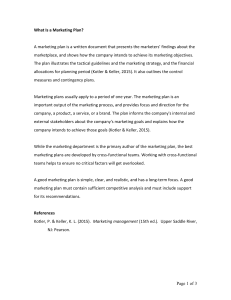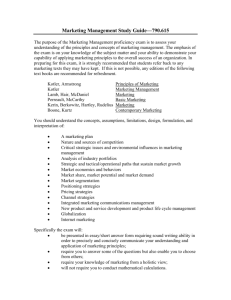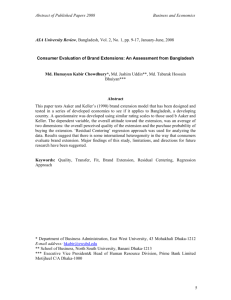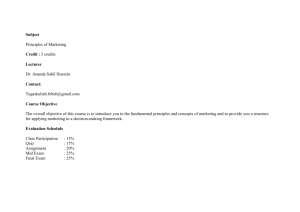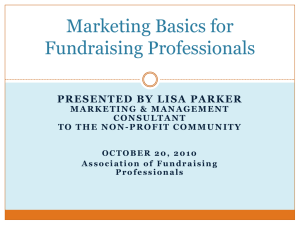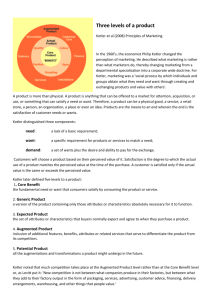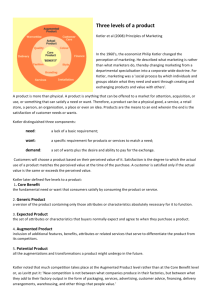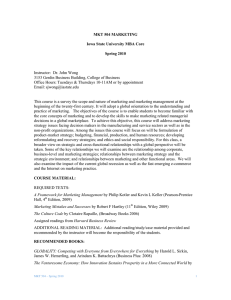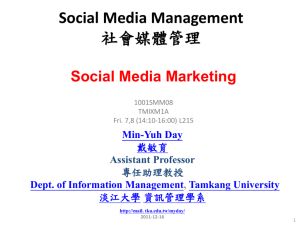Marketing Research
advertisement
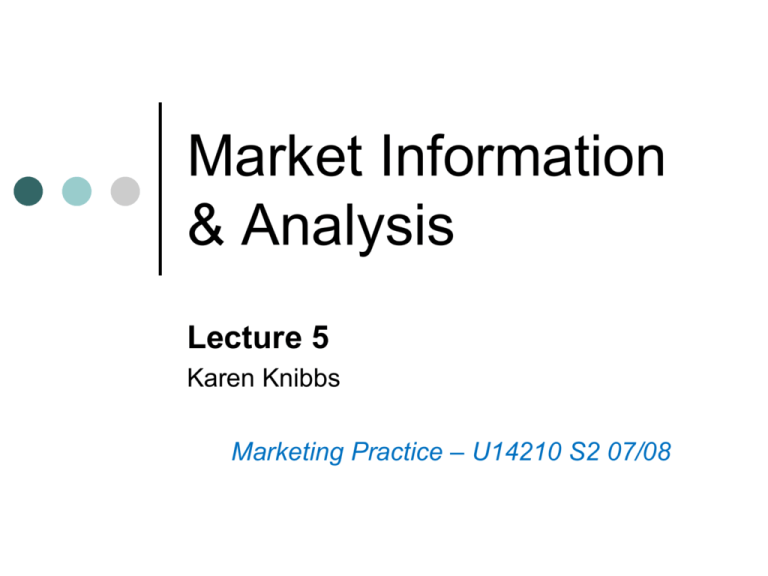
Market Information & Analysis Lecture 5 Karen Knibbs Marketing Practice – U14210 S2 07/08 Lecture Objectives By the end of the lecture, you should be able to: Identify the typical types of information which marketers would use Understand a range of methods of collecting & measuring information Evaluate the significance of MR data to marketing decision making Consider the case of Tesco’s use of information 2 Kotler & Keller (2006) 3 ‘Information is the competitive advantage that drives success…just so long as the information is appropriate and adequate and we know how to use that information! Competitors can copy and better equipment, processes and products but they can’t replicate the company’s information and intellectual capital.’ MR in the Marketing Process from last week… MR information needed at all stages: new product idea generation and product development marketing testing launch implementation brand performance management positioning and repositioning etc 4 Why the need for metrics? Corporate demand for accountability Attempts to curb spiralling costs, longrange budgeting • spend in advance of return (ROI) - ROM • Legitimacy and credibility for marketers in the eyes of senior managers Discontent with traditional measures Enhanced availability of data due to new technology and internet infrastructure 5 The value of intangible assets “Today intangible assets are worth, on average, 69% of the firm’s total market value as compared to 17% in 1978 (Sawhney & Zabin, 2002). If marketing expenditures are an investment, and the creation of marketing are assets, then it is of utmost concern that their assets be valued by metrics in use.” Seggie, Cavusgil & Phelan (2007) 6 Typical marketing data How tangible are these data and how are they collected / measured? Market share Market growth Brand value ROI in M/ ROM: marketing productivity Competitive Advantage 7 Demand estimation Estimation of market demand is essential for effective marketing and as illustrated below, demand is measured on a number of levels. Kotler & Keller (2006): Ninety types of demand measurement (6 5 3) Types of market Potential market • Consumers have some stated interest in a product or service. Available market • Set of consumers who have the interest, income and access to the product or services. Qualified available market • Set of consumers who have the interest, income, access and qualifications for a particular product or service. Served or ‘target’ market • Part of the qualified market that the company decides to pursue. Penetrated market • Set of consumers that have already bought a particular product or service. 9 Measuring market demand “The total market demand is the total volume of a product or service that would be bought by a defined consumer group in a defined geographic area, in a defined time period in a defined marketing environment under a defined level and mix of industry marketing effort.” Kotler & Keller (2006) 10 Measuring market demand Kotler & Keller (2006): Market demand 11 Types of demand The primary demand is the total demand for all brands of product and services (e.g. music downloads, MP3 players, mobile phones, laptops) The selective demand is a specific demand for a given brand of product (e.g. iTunes, iPod, iPhone, iMac etc.) 12 Estimating market demand Q= n x q x p Where • Q = total market demand • n = number of buyers in the market • q = quantity purchased by an average buyer per year • p = price of an average unit 13 Forecasting future demand Environmental forecast Industry forecast What is currently happening? Company sales forecast 14 Inflation, Unemployment, Interest rates, Consumer spending and saving, Business investment, Government expenditure. Buyers’ intentions, Composite of sales force opinions, Expert opinion. Test market method. Time series analysis, Leading indicators, Statistical demand analysis, Information analysis. Qualitative & Quantitative data Accounting (tangible) data Based on actual, financial, quantifiable ‘fact’ Typical historical then future projections / forecasts / benchmarking If these are inaccurate, planning is futile Non-accounting (intangible) data Tend to be qualitative & subjective in nature Considers long-run wealth creation & future development 15 Intangible metrics Accounting measures: Non-accounting measures: Balanced scorecard Customer contribution (Kaplan & Norton, 1992) EVA (economic value CE: customer equity added) Stewart 1993 Where expenditures are seen as future investments instead of only current costs • But financial measures must also consider impact of competitive actions 16 (Blatberg & Deighton 1996, Zeithaml & Lemon 2000) CLV: customer lifetime value (Jackson 1989, Jain & Singh 2002) Balanced Scorecard 17 “Intangible assets” Seggie, Cavusgil & Phelan (2007) Competitive advantage Knowledge, Networks Innovative capability Equity (brand-financial, brand-psychological, relational & customer) Plus: 18 USP/differentiation, Positioning, Perception Customer satisfaction, WOM recommendation Behavioural intent, loyalty, perception What to measure?: Products Competitive advantage: “sustained differentiation from rivals” (Barney 1991; Wernerfelt 1984) Declines over time Is context specific: to competitors and uncontrollable environmental forces (PESTLE) • For one company, could be in the form of price premium, e.g. Jaguar, Ipod, Bang & Olufsen, Gucci • Which can be used as a “measure of brand health & brand equity” (Alawadi, Neslin & Lehmann 2003) 19 What to measure?: Services Tend to involve subjective measures E.g. Customer satisfaction, loyalty, perception But informational power of the Internet is making objective attributes (i.e. company history, customer recommendations etc., which appear as “factual”) increasingly important, and brand loyalty is declining (Bennett & Rundle-Thiele 2005) Brand equity is now measured on future expectations and “what have you done for me lately” consumer philosophy, reducing brand halo effect • E.g. Bank, Mobile network provider, Utilities, Fitness centre 20 Collection methods Data capture (passive) ECR: electronic cash registers Databases: data mining & warehousing CRM: micro monitoring of customers ERP software Online purchases, accounts & direct contact/feedback 21 Data collection (active) Online surveys Consumer (internet) panels Shoppers upload info on purchases Mystery shoppers Profit per customer interaction & CLV Looking through existing customers? Identifying potential customers? Forecasting future demand Kotler & Keller (2006) Common sales forecasting techniques 23 Tesco’s – how much do they know about you? 24 Why are Tesco’s so nosey? 25 Identification of segmentation profiles of various target markets Above added to typical purchase frequency, channel choice (store or online), value of orders, best/worst performing products/services (for category management decisions), utilisation of sales promotions and responses to direct communications (past performance) Identify opportunities to cross-sell, make changes (future performance) Global research Business globalisation is increasing the demand for accurate local and regional information on the new markets to be entered. Research needs to cover everything from cultural issues to consumer behaviour and competitive activity. 26 Marketing research in small businesses and non-profit organisations Often limited by budgetary constraints, but the following can be accomplished: Observation of market, competitors and industry Secondary data collection Surveys Experiments 27 Summary 28 Accurate information enables intelligent decision making in pursuit of organisational objectives Information must be continuously collected, monitored, analysed and communicated all around the organisation (via a MIS) More information is necessarily helpful, but better use and understanding of it to drive marketing decision making is imperative The internet is becoming a key information source for businesses and consumers alike, but all must be wary of the reliability and credibility of the data Further reading suggestions Kotler & Keller (2006) chapter 4, as per unit handbook. 29 Chisnall (2004), Marketing Research, (7th Ed.), McGraw Hill. Doyle, P (2000), Value Based Marketing, John Wiley. Seggie, S., Cavusgil, E. & Phelan, S. (2007). Measurement of return on marketing investment: A conceptual framework and the future of marketing metrics. Industrial marketing management. 36, 843-841.
